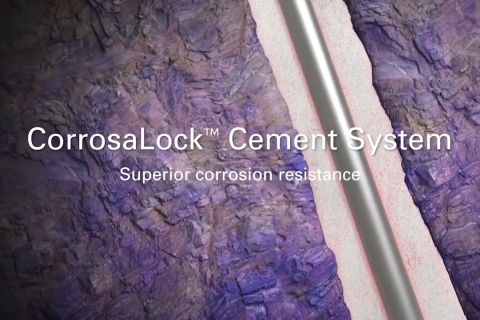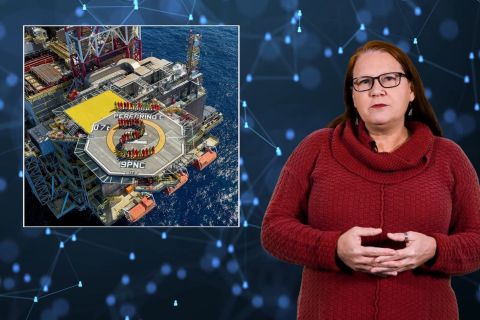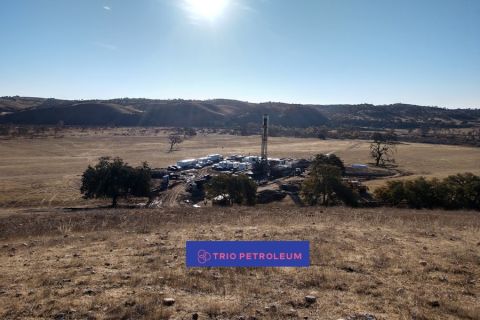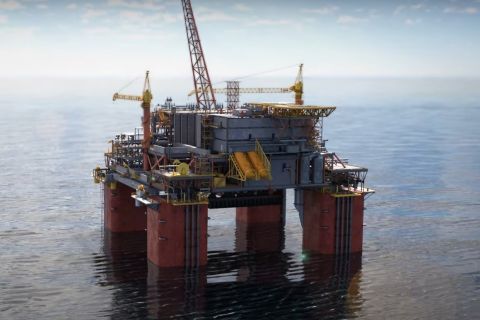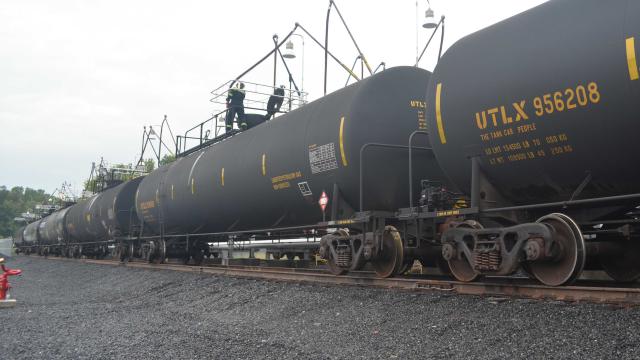
Rail terminals create key hubs in moving LP gas from suppliers to customers, but proper procedures must be followed to make sure they meet standards and make full use of available technology. (Source: Superior Energy Systems)
Rail is crucial to transporting propane to where it is needed, especially when customers are not in close proximity to a propane pipeline. Rail car-supplied propane terminals help keep propane costs stable because they eliminate the need for additional trucks to transport the fuel great distances to rural areas, where it is used for home heating, agriculture and other uses.
Utilizing a terminal builder with experience in all of these areas can make a substantial difference in the success of the build and operation.
Terminal design
Overall design and terminal storage need to be addressed first and foremost when building a rail terminal operation. Distances and aggregate storage capacities—total storage available—can place certain limits on storage and rail capabilities. It is also critical to assess necessary storage required to meet regional peak demand.
The midstream supplier must assess past purchases, logistics associated with moving fuel from nearby refineries, and geographic needs based on historical data, and supply and demand.
The National Fire Protection Association (NFPA) 58 code regulates container spacing. A maximum of six storage containers can be located in a group, regardless of size, and the code requires 50 feet of separation between groupings.
The most critical part of building an advanced rail car-supplied propane terminal lies in efficiency in both rail switches and the unloading of propane tank rail cars. The responsibility of the rail switch falls on either the midstream marketer/terminal owner or the railroad operator. When a rail terminal is built, many logistical motions come into play related to the movement or addition of track, the amount of rail car storage and the necessity of separate onsite or offsite rail car storage locations.
The addition of rail siding is necessary to offload rail cars off of the main rail line. Average rail cars range from approximately 50 to 60 feet in length with a turning radius of approximately 240 feet. Engineering software programs allow terminal builders to determine the amount of land and length of rail siding required to meet the switch demand.
The switch demand, therefore, determines the number of gallons the midstream supplier will be able to move out of the terminal in a 24-hour period.
Rail car unloading
The efficient unloading of tank rail cars affects the entire terminal operation, determining the speed that gas is unloaded and subsequently, the number of tanker trucks that can be loaded in a given amount of time.
The amount of land space determines single- or double-sided rail towers. Double-sided rail towers are much more efficient, allowing unloading personnel to unload two cars without walking farther down the rail car line. Double-rail car siding requires more land space, and the two rail lines must be separated by 21 feet, allowing the rail cars to move with ease. If less land is available, single rail towers are placed along the siding, requiring personnel to travel to each tower to connect rail cars to the liquid transfer system.
Compressor size and unload pressures make a crucial difference in offload speed, as does the process used to remove the propane. Top connections are used to remove liquid propane, due to the nature of the fuel.
Vapor removal and recovery is a significant detail that must be taken into account as well, in order to avoid losing potentially thousands of gallons of fuel over time.
Compressor size affects the time required to move liquid from rail cars to storage tanks. It also directly contributes to the time required to recover valuable vapors from an otherwise empty rail car. Larger displacement compressors have the ability to recover vapor faster, but require larger motors, which consume additional electricity during the transfer/recovery process. A highly efficient terminal with 15 spots has the ability to offload about 1 million gallons per day.
Truck transport
Also important in rail terminal efficiency is the truck transport loading process. Land space determines the access road and driveway available to maneuver and stage transport trucks. To meet high-performance requirements, terminal operations load trucks at a rate of 550-600 gallons per minute, allowing a transport truck to be filled in less than 15 minutes.
At the truck loading rack, truck metering skids are calibrated for accurate custody transfer. Automation is also key. Bill-of-lading management, the programmable logic controller (PLC), tank-level system and terminal management software all come together to benefit both the marketer and the customer.
Additional automated features, such as a lockable gate-control system necessary for terminals open 24 hours a day with unattended access, must be installed to meet NFPA code. The NFPA standard serves as the industry benchmark for safe propane storage, handling, transportation and use.
Permitting, safety, compliance
Permitting, safety standards and code compliance are key measures that must be taken into account in a rail terminal project. Terminals must meet expectations and regulations set by NFPA 58, the local government authority having jurisdiction (AHJ), and various local and regional entities including the fire department, city and zoning departments.
Adding the following aspects helps ensure a safe and compliant operation:
OSHA rail guards—Permanent hand rails are installed alongside the rail towers and stairs. Removable safety rails are designed in a hoop-like shape to move up and down with the catwalk, providing the OSHA-required 42-inch fall protection. The rails enable the operator to complete their task without the use additional safety tie-off or harness mechanisms.
These features streamline the connection of rail cars for unloading or loading.
Shutdown devices—Operator devices that are installed per NFPA 58 code, in convenient locations at each rail tower, enable operators to open and close the liquid and vapor connections to each rail car. In addition, one emergency shutdown device is installed 20 to 100 feet from the point of transfer, which can be used to close connections to the entire rail rack.
Hydrocarbon leak detection—Detection mechanisms installed around points of transfer and pumping systems (vapor compressors and liquid pumps) to detect propane leaks. When detected, the leak is reported to the PLC, enabling the emergency shutdown device and closing all valves to contain the leak.
Fire hydrant/monitor nozzles—A fixed nozzle or hydrant is installed at ground level around the tanks to provide cooling to the tank in the event of fire. The installation of nozzles reduces tank separation requirements set by NFPA 58, allowing additional tanks to be installed in closer proximity.
Backflow check valves—Safety valves that allow propane to flow into the piping system, but not back out, are critical in case of hose separation or piping damage.
Positive shutoff valves—Valves installed throughout the terminal allow for convenient isolation of various portions of the system to allow for service, without having to evacuate the entire piping system. They also provide a redundant positive shutoff in conjunction with emergency shutoff valves.
Breakaway devices—Installed at unloading stanchions to separate at a predictable point in the event of an accidental transport truck pull-away, preventing damage to the loading or unloading equipment and loss or product from the system.
Hydrostatic relief valves—Installed in the piping system at any point where propane has the potential to be isolated between two positive shutoff valves. This protects the piping system from excessive pressure due to liquid expansion from an ambient temperature increase.
Crash posts—Located around all tanks or piping. The posts protect the system from damage by vehicular traffic accidents.
Fire safety
In addition to the measures mentioned above, the terminal supplier develops a Fire Safety Analysis (FSA), required by NFPA 58. The main goal of the code is to prevent any unintentional release of propane into the atmosphere.
The FSA must be completed prior to terminal operation but is often required much earlier, during the permitting process. The FSA determines the safety of the terminal itself based on safety features required by NFPA and additional measures put into place to prevent propane release accidents.
Key sections of the FSA include:
- Installation description and applicable codes;
- Evaluation of the total product control system;
- Analysis of local conditions; and
- Probable effectiveness of local fire departments.
The FSA ensures the terminal will be built to—and likely exceed—customer requirements, along with appropriate federal, state and local codes and standards. The standards require that:
- All container openings are properly equipped to meet the requirements that incorporate mechanical, thermal and remote means of operation, including activation and emergency shutdown as required by code;
- Containers have the required liquid level devices, such as a float gauge, rotary gauge, slip tube gauge or a combination to prevent overfilling;
- Vapor pressure and temperature gauges; and
- Properly sized tank relief valves to protect the tank from overpressure.
Challenges and solutions
Soil preparation can create certain challenges that must be addressed prior to a build. Existing utilities including power, water and site drainage must be taken into account and prepared to handle the new operation. Various site challenges and solutions can include the following:
Soil contamination—Existing soil can be contaminated with various substances including arsenic, industrial waste and stone formations. Contaminated soil must be removed and relocated to a containment facility. High-compaction fill is added to replace the layers of contaminated soil according to the site plan elevations.
Drainage—The challenge comes from underground and aboveground streams, or wetlands, existing in various locations around the site. The water source must be rerouted with underground tiles, swales and retention basins to drain away from facility.
During construction, existing water must be pumped out to install any foundations. Landscape shrubbery, including plants and trees, and river rock and retention walls, can also be installed around the site perimeter to aid in soil conservation and water erosion.
Permitting—Difficult site conditions, including differing soil conditions around the site, can cause each area of the terminal to be separately designed. In that situation, most local jurisdictions require separate building permits for each structure—buildings, rail towers, truck loading stations, tank piers and compressor foundations. This can create additional timing and engineering challenges. Overcoming authority misconceptions, including that propane is a dangerous gas, has also become part of a process that can be challenging.
The solution can be to utilize a reputable builder with the knowledge, experience and resources to identify site challenges prior to construction. The builder should have the ability to estimate timing and engineering resources accordingly and meet requirements and expectations of the AHJ, regardless of misconceptions.
Commissioning
The terminal supplier will begin the commissioning process about two weeks before project completion, which includes testing the installation of every part of the system per the design plan.
- The rigorous evaluation process includes:
- Performance and function testing of the compressors, pumps and motors;
- Pressure testing the piping system;
- Testing of the PLC, the core of the terminal’s system;
- Testing of additional safety systems, including the hydrocarbon detectors, liquid level systems and emergency safety devices; and
- Meter calibration.
The terminal contractor then coordinates all inspection approvals to ensure compliance with each permit, including walk-throughs by all inspectors.
Following full testing and inspection approvals, the terminal’s onsite operations personnel should be trained. Local AHJ personnel also are trained on the terminal’s features and safety systems.
The start-up and first product-transfer is often monitored by the terminal contractor, as well as the operations team.
Experience counts
Rail car-supplied terminals are integral part of the midstream propane landscape, for the simple fact that they ensure propane gets to where it is needed. Terminals allow transport trucks to drive shorter distances for fuel deliveries to local propane providers. This makes the delivery process more cost-effective for those local and regional propane providers.
Developing a rail car-supplied propane terminal is a complex process that requires a high level of design and engineering acumen to ensure a terminal is a safe place that meets requirements of national and local authorities as well as the governmental AHJ. In other words, experience counts, and working with a provider that specializes in the nuance of terminal building can significantly increase your savings in both capital and time.
Recommended Reading
Tech Trends: Halliburton’s Carbon Capturing Cement Solution
2024-02-20 - Halliburton’s new CorrosaLock cement solution provides chemical resistance to CO2 and minimizes the impact of cyclic loading on the cement barrier.
Tech Trends: SLB's Autonomous Tech Used for Drilling Operations
2024-02-06 - SLB says autonomous drilling operations increased ROP at a deepwater field offshore Brazil by 60% over the course of a five-well program.
Trio Petroleum to Increase Monterey County Oil Production
2024-04-15 - Trio Petroleum’s HH-1 well in McCool Ranch and the HV-3A well in the Presidents Field collectively produce about 75 bbl/d.
Deepwater Roundup 2024: Offshore Europe, Middle East
2024-04-16 - Part three of Hart Energy’s 2024 Deepwater Roundup takes a look at Europe and the Middle East. Aphrodite, Cyprus’ first offshore project looks to come online in 2027 and Phase 2 of TPAO-operated Sakarya Field looks to come onstream the following year.
Deepwater Roundup 2024: Offshore Australasia, Surrounding Areas
2024-04-09 - Projects in Australia and Asia are progressing in part two of Hart Energy's 2024 Deepwater Roundup. Deepwater projects in Vietnam and Australia look to yield high reserves, while a project offshore Malaysia looks to will be developed by an solar panel powered FPSO.

